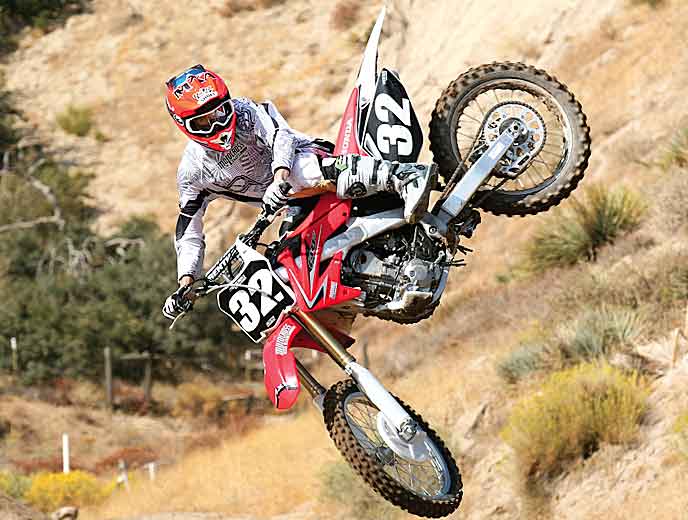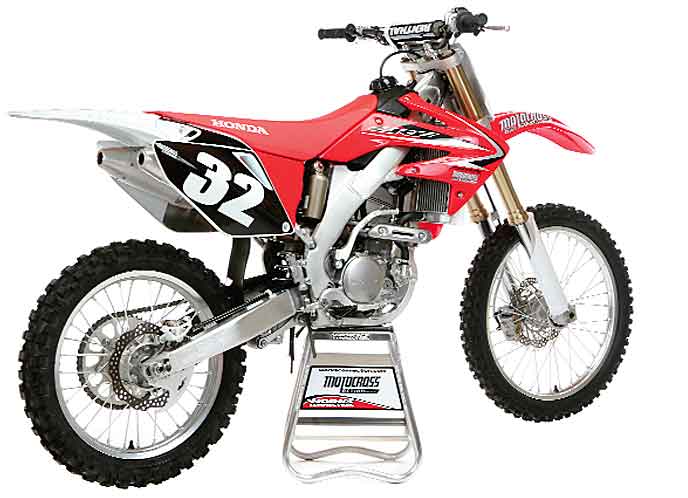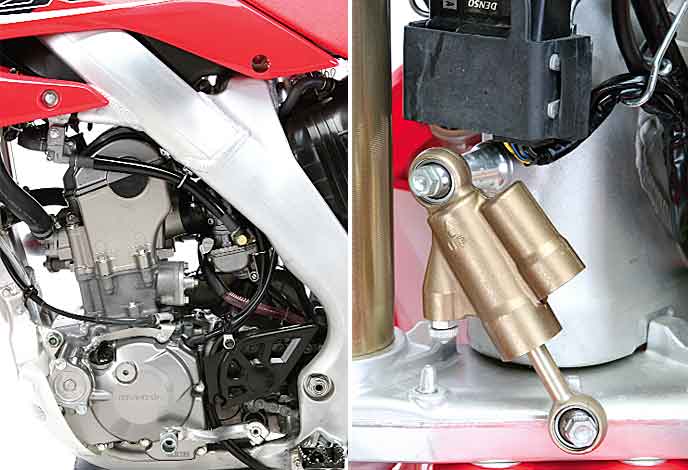2009 Honda CRF250; Suspension Settings, Jetting Specs, Likes & Dislikes, Plus Much More
INSIDE TEST OF THE NEW 2009 HONDA CRF250

You may be surprised to learn that while the Honda CRF250 has been the best-selling 250 four-stroke motorcycle since its inception in 2004, it has never garnered MXA’s 250F of the Year award. That honor and distinction, at least for the last three years, has belonged to the Kawasaki KX250F. While the CRF250 has gained ground on the KX250F in recent years, the fly in Honda’s missing “Bike of the Year” ointment has always been carburetion, powerband and suspension issues that couldn’t be overlooked.
You don’t need a degree from the Wharton School of Business to understand why the 2009 Honda CRF250 is the spitting image of the 2008 model. All available R&D money was spent on the CRF450. With Honda investing beaucoup dollars into the fuel-injected CRF450, the money well dried up before the CRF250 came on line.
Does that mean that the 2009 CRF250 is the 2008 CRF250 with Bold New Graphics? Yes and no. In actuality, the 2009 CRF250 is a mildly massaged version of the 2008 CRF, which was only slightly different from the 2007 model. That assessment may sound negative, but Honda’s engineers were able to get their hands dirty on the 2009 model, and the MXA wrecking crew was delighted to find that what few things they did made a big difference.
The MXA test crew liked the 2008 CRF250, but does that mean we like the 2009 version? Find out.
Q: HOW MANY CHANGES CAN BE FOUND ON THE 2009 CRF250?
A: The 2009 model year will not be remembered as the year when Honda went whole hog on the CRF250. We can’t blame them. Business is business, and Honda prioritized its development dollars on the electronic fuel-injected CRF450. That doesn’t mean that Honda didn’t work on the 2009 CRF250. They did. To be exact, the CRF250 received seven updates.
(1) Head. The cylinder head’s combustion chamber shape was changed to improve power from low-to-mid rpm. Honda increased the area around the valve pockets to improve the burn pattern.
(2) Head pipe. The exhaust header length has been increased by 30mm to work in conjunction with the new
cylinder head for improved power.
(3) Transmission. To sharpen the shifting, Honda implemented smaller four-dog transmission gears (changed from three dogs in 2008), revised the shift drum and redesigned the shift drum arm.
(4) Brake rotors. Honda shaved 1.3 ounces off the 240mm front brake rotor. The rear brake also received the Jenny Craig treatment to the tune of one ounce. Both rotors got a cauliflower shape for greater ventilation.
(5) Disc guard. Honda cut four grams off their new front disc guard. The axle spacer is also molded directly into the plastic guard for easier installation.
(6) Paint. Honda gave the cylinder head cover, clutch cover and left side cover the gray paint treatment.
(7) Grips. Gone are the A-bomb-proof grips. Not only is the 2009 compound softer, but the grips are 3mm longer.
Q: IS THE 2009 CRF250 FASTER THAN THE 2008 MODEL?
A: Before we answer that question, let’s refresh your memory on the powerband of the 2008 CRF250. Last year we stated that “the CRF250 takes its time going through its powerband. And while this makes it very easy to ride, it isn’t the quickest way to get from gear to gear or corner to corner.”
In short, the 2008 powerband was wide and smooth, but it lacked a hard hit or abundant over-rev. It was a good engine, but not snappy and responsive enough to take the top spot. For 2009, Honda, realizing that the 250 four-stroke consumer had an affinity for hard-hitting and higher-revving engines, focused their attention on the two problem areas: midrange snap and top-end howl.
Did they accomplish their goals? Yes. The 2009 powerband is significantly better than the 2008 curve. It pulls stronger off the bottom, drives through the midrange, and carries more power over the top. Very good.
Q: WHAT DOES THE 2009 CRF250 POWER LOOK LIKE ON THE DYNO?
A: It is impressive. Compared to the 2008 CRF250 engine, the 2009 powerband has one more horsepower at 6000 rpm, then matches last year’s output up to 10,000 rpm, where it takes off again to a one horsepower advantage all the way to 12,000 rpm. That’s serious improvement! The CRF250 peaks at 37.02 horsepower at 10,500 rpm.
The only 2009 250 four-stroke that makes more horsepower than the CRF250 is the KTM 250SXF.
Q: HOW DOES THE 2009 CRF250 ENGINE COMPARE TO ITS COMPETITION?
A: With only small changes to the cylinder head and exhaust pipe, Honda engineers made significant improvements to an already solid engine. In last year’s round of tests, the MXA wrecking crew rated the CRF250 engine second behind the 2008 Kawasaki KX250F powerplant.
On the plus side for the 2009 CRF250, the increase in bottom-end hit and top-end power, while maintaining the same strong mid-range, is enough to surpass the green machine as candidate number one for the 2009 powerband crown. Honda kicked out the jams and created a do-it-all engine that works well in most conditions.
On the downside, there were test riders who felt that the KX250F powerplant hit harder off the bottom and pulled stronger in that 6000 to 10,000 rpm range where the 2009 CRF250 runs just like the 2008 model. But even these naysayers admit that the Honda redeemed itself once above 10,000 rpm.

Q: DOES THE CRF250 STILL HAVE THE HPSD DAMPER?
A: Yes, but in reality the Honda Progressive Steering Damper isn’t completely necessary. Honda thought that the switch from 24mm offset triple clamps to 22mm offset in 2008 would create instability. We never felt this, because we had been running 22mm offset clamps on our CRF250’s since 2005.
As a rule of thumb, once a major manufacturer adopts proprietary technology (like HPSD or twin mufflers) they are prone to stick with it whether it adds anything to the package or not. It’s a pride thing. Maybe it is just us, but while we can see some benefits to the steering damper, we are puzzled by Honda sticking with the CRF250’s twin pipes. What’s the point? The twin exhaust is heavier, not necessarily quieter, doesn’t produce a major power advantage, costs more to replace and is more prone to damage.
Q: DOES THE 2009 HONDA CRF250 HAVE JETTING ISSUES?
A: Sadly, yes. The Honda CRF250 has had a serious bog problem since 2006 (when Honda dropped the 37mm Keihin for a 40mm carb). Every year since 2006, Honda has tried to improve the stock jetting. And every year the MXA wrecking crew has to dig through boxes of needles and jets to try to find a repair patch.
As it sits, the 2009 CRF250 bogs. The jetting is too lean. It’s better than the 2008 model, but the bike still has an irritating hesitation when landing from jumps. Since it’s starved for fuel, it is also the most difficult bike to start in the 250F class (when cold or hot).
Q: WHAT DID WE DO TO THE STOCK JETTING?
A: Our best fix was to richen the pilot jet, leak jet and needle. Here are MXA’s recommended jetting specs:
Main: 185
Pilot: 45 (42 stock)
Needle: NNWT (NNSU stock)
Clip position: Third from top
Fuel screw: 1-1/4 (2-1/4 stock)
Leak jet: 60 (70 stock)
Notes: Adjusting the fuel screw creates a tradeoff between ease of starting and richness in bottom-end power. The stock Honda jetting works best in hot conditions. Otherwise the needle, fuel screw, pilot and leak jet will need to be changed. The NNWT needle is one-half a clip richer than the stock NNSU needle.
Q: DOES THE STOCK GEARING WORK WELL?
A: In the past, MXA test riders have always toyed with lower gearing (especially for Novice, Beginner or Vet riders). Thankfully, the added low-end punch on the 2009 model lends itself to working much better with the stock 13/51 gearing. Regardless of skill level or motocross track, we were pleased with the gearing. With that said, those who ride Supercross or Arenacross-style tracks will still benefit from an extra tooth on the rear sprocket.
Q: HOW GOOD IS THE CRF250 SUSPENSION?
A: The 2009 CRF250 suspension components are relatively unchanged from 2008. Honda made slight clicker adjustment settings on the Showa forks for 2009, but the root of the CRF250’s problem?mid-stroke harshness?is as it was.
As it sits, the 2009 CRF250 is unbalanced. Worst of all, the forks are unforgiving. Fortunately, the fork problems can be solved with one simple trick. Forget about revalving the forks, changing the fork springs or making radical clicker adjustments, because, in our opinion, the issue lies in the fork oil height. Simply lowering the oil height by 10cc will allow the Showa forks to move smoothly and consistently through their stroke.
How difficult is it to bleed oil out of the forks? Very easy. Follow these steps: (1) Remove the front wheel, front brake caliper and forks from the bike. (2) Unscrew the air bleeder screw on the top of each fork. (3) Tip the fork on its side and pump the lower fork tube. (4) Fork oil will drain out of the forks. (5) Drain 10cc of oil into a cubic centimeter measuring cup. (6) Replace the bleeder screws and reinstall the forks.
Q: WHAT WERE OUR BEST FORK SETTINGS?
A: For hardcore racing, these are MXA’s recommended 2009 Honda CRF250 fork settings:
Spring rate: 0.46 kg/mm
Oil quantity: 398cc (408cc stock)
Compression: 11 clicks out (seven stock)
Rebound: Nine clicks out
HPSD: Seven clicks out
Fork leg height: Flush with top clamp
Notes: Smaller riders should lower the oil height by an additional five to 10cc to allow the forks to use their full stroke. Also, we set the HPSD at seven clicks out and adjusted for faster (turn in to slow damping) or tighter (turn out for lighter damping) tracks.

Q: WHAT WAS OUR BEST SHOCK SETTING?
A: For hard-core racing, these are MXA’s recommended 2009 Honda CRF250 shock settings:
Spring rate: 5.3 kg/mm
Race sag: 102mm
Hi-compression: Two turns out (2-1/8 stock)
Low-compression: 16 clicks out (11 stock)
Rebound: Six clicks out (11 out)
Notes: The shock is very sensitive to high-speed compression. Heavier riders might want to go in a quarter turn and set the sag at 100mm. Lighter riders will like MXA’s recommended settings, although the sag should be set to 104mm.
Q: WHAT DID WE HATE?
A: The hate list:
(1) Jetting. We miss the no-nonsense 37mm Keihin carburetor on the 2005 CRF250. The 2009 carb takes patience and a lot of brass to make it work the way it should out of the crate.The big carb is stupid when they first put it on the CRF250 and it is still stupid.
(2) Forks. These puppies are harsh! Thankfully, there is a quick fix that can erase the mid-stroke harshness in the Showa units. Dropping the oil height by 10cc makes all the difference in the world.
(3) Front tire. Although Dunlop’s D742FA is marginally better than the original D742, it still isn’t a great tire. Ditch the front tire for more terrain-specific rubber.
(4) Front brake guard. Having the spacer molded into the front brake guard makes axle installation easier, but the MXA wrecking crew believes that the disc guard hinders air flow to the front brake. When we suffered brake fade, we removed the disc guard. Unfortunately, because of the molded-in spacer, we had to use a hacksaw. Ride Engineering makes a replacement wheel spacer if your aren’t a hacksawing wielding butcher (and want to save the disc guard for a day when you want brake fade).
(5) Footpegs. Many manufacturers have stepped up to the plate by delivering wider footpegs. Not Honda. The CRF250’s footpegs are small and store dirt with great efficiency (that is not a good thing).
Q: WHAT DID WE LIKE?
A: The like list:
(1) Power. The biggest improvement on the 2009 CRF250 is the powerband profile. The power doesn’t build as slowly as last year, plus Honda’s engineers were able to pump up the horsepower significantly. Kudos to Honda.
(2) Handling. After adopting 22mm offset triple clamps in 2008, the CRF250 has become one of the better handling bikes in the class. Change the front tire and you will be even more impressed with the handling characteristics.
(3) Ergonomics. Every test rider, from short to tall and small to large, felt immediately comfortable on the 2009 CRF250.
(4) Grips. If hands could talk, ours would be saying how happy they are to be riding with Honda’s new
softer compound grips. Not only are they 3mm longer (for bigger hands), but they won’t abuse your palms.
(5) HPSD. Most MXA test riders don’t think that the CRF250 needs it, but we like the option of tightening the steering damper for high-speed tracks.
(6) Handlebars. We like 7/8-inch handlebars. Always have and always will. Honda’s stock Renthal 971 bend is pretty sweet.

Q: WHAT DO WE REALLY THINK?
A: The 2009 Honda CRF250 is a perfect example of a manufacturer taking a solid package, making only a
thimble-full of refinements, and emerging with a motorcycle that is remarkably better than the previous year. The 2009 Honda CRF250 may still have a few peccadilloes, but these shortcomings are far outweighed by the powerband and handling.




Comments are closed.